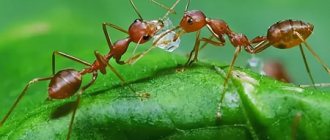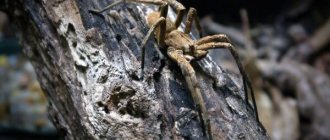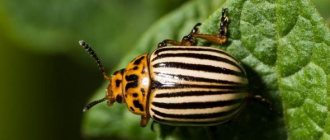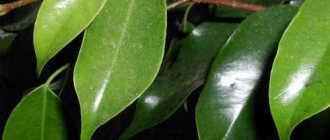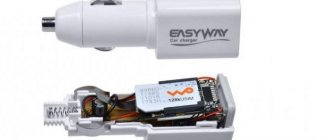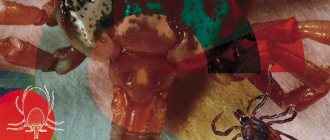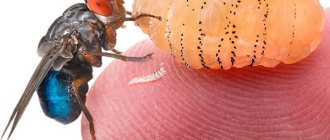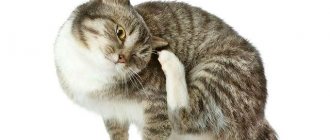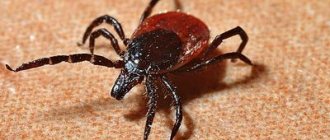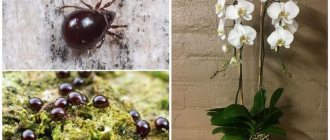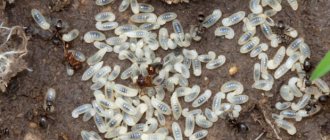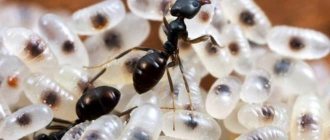Hierarchical ladder
- Fact:
Each resident of the anthill has his own specific responsibilities, but all efforts are aimed at only one thing - the protection, strengthening and prosperity of his large family. - Fact 2:
Some ant species have insect soldiers that are unable to feed on their own. The workers are forced to feed them. - Fact 3:
Worker ants are divided into several subgroups within their group. Who performs what duties depends on the individual qualities of each insect. - Fact 4:
A little ant is able to lift and carry weight 50 times its own! And if several insects join forces, the number increases to 70-80!
Ants are gregarious insects. There are no solitary or hermit ants. All varieties of these small workers live in colonies. Each resident of the anthill has his own specific responsibilities, but all efforts are aimed at only one thing - protecting, strengthening and prosperity of his large family .
Ant "table of ranks"
Communication and mutual contact between fellow tribesmen is carried out using channels (signal and food). The colony is conventionally divided into “detachments”:
- Workers.
- Soldiers.
- Females.
- Males.
At the head of this legion is the queen, also known as the queen . The uterus has the largest size. This is a real egg production conveyor. The working group of ants is required to care for eggs and pupae, search for and prepare food, repair and strengthen the anthill. A detachment of guard ants, the so-called soldiers, perform protective functions, guard entrances and deal with strangers. Females and males are destined for the role of participants in the process of reproduction.
Females are more important
The leaf-cutter ant, whose lifestyle is certainly interesting, also reproduces in an original way. To raise insects capable of reproduction, special individuals fatten the larvae, adding special substances to their food that stimulate sexual development. The females and males that grow from these larvae mate with each other. Moreover, the female needs a large amount of sperm, so she mates with several males. After mating, which lasts only one day, the males die.
Soldier Ants
Anthill defenders are a subspecies of the worker ant, but with slightly larger dimensions. Some ant species have insect soldiers that are unable to feed on their own. The workers are forced to feed them.
The main function of a soldier is protective. It protects the anthill, food supplies and foraging ants. A secondary task is to help dismember large prey into pieces if the worker ant is not able to carry it away entirely.
Hybrids
Sometimes hybrid forms of insects are born.
Something between a worker and a soldier. Such ants are approximately one and a half times larger than ordinary workers, but are smaller in size than the queen. Remember:
no matter who is born in the ant farm, there is no need to interfere with the natural course of events. The ants themselves will figure out the identity of the new member of the anthill.
Also, do not expect soldiers to quickly appear in the formicarium. In order for soldiers to appear, it is necessary to create comfortable living conditions for the queen and the entire anthill. In addition, it is important to avoid stress factors: bright light, loud sounds and vibrations near the formicarium.
And only when the queen feels comfortable enough will she lay a large egg, from which the first soldier will subsequently emerge.
Worker ants
This is the largest group of inhabitants of the anthill. The first ones to appear after the queen lays the first chamber of the future anthill are the builder ants. He expands and strengthens the future underground kingdom, takes care of future offspring.
Working ants are divided into several subgroups within their group. Who performs what duties depends on the individual qualities of each insect. For example, individuals with proactive inclinations and reactions become hunters or scouts. The more sedate ones graze and spread aphids to plants and collect their sweet honeydew. The change in activity can only be influenced by age, when the old ant is no longer suitable for reconnaissance or hunting, or the sudden death of most of the colony.
Young specimens work underground, inside the anthill. They build new cells, dig passages, and care for larvae and females.
What's the harm?
Many species of ants are considered beneficial to humans, but two species - turf and garden ants (black and red) - cause harm to gardens and vegetable gardens. In particular, these insects use the sweet secretions of sucking pests as an additional (and sometimes the main) source of nutrition. For this reason, ants protect aphids, psyllids, scale insects and false scale insects from attacks by enemies, and contribute to their settlement and reproduction. And our plants are left with bloodless leaves, contaminated with sticky honeydew, which serves as a breeding ground for sooty fungi.
In addition, the inhabitants of anthills damage the roots, eat the seeds in the soil without leaving a trace, and gnaw on seedlings and seedlings with appetite.
Article on the topic
4 Best Ways to Control Ants
Ants' Strength and Endurance
They say about some people: “Works like an ant.” And it does not mean that the result of his work is microscopic. On the contrary, it is praise denoting a gigantic job done alone. The comparison with insects is not accidental. Few in the animal world can boast of such strength and endurance. The little ant is able to lift and carry weight 50 times its own! And if several insects join forces, the number increases to 70-80! This is because the ant's body structure is dominated by muscle tissue. Considering the size of the anthill and the number of “freeloaders” that the worker ant provides with food, it is clear that it is not at all superfluous in strength. A stubborn insect, if unable to lift and carry large prey, will drag it along the ground behind it until help arrives.
Surprisingly, when an obstacle appears on the way, the ants cling together with their paws and form living bridges up to several meters long. This is usually necessary to overcome a stream, a crevice, or any place where it is not possible to walk on the ground. So, such a bridge can withstand a load of several kg.
original name
To better understand the process of creating a new colony of ants, we need to go back to why leaf-cutter ants got their name. Observing these insects, people concluded that they feed on plants. This happened because the leafcutter ant, common in America, destroys plant leaves. If the colony gets down to business, then in a short period of time only branches and a trunk will remain from the tree. What do they do with the leaves? Are eating? This assumption turned out to be incorrect. Yes, indeed, leaf-cutter ants, the description of which you will find in this article, chew leaves, but not in order to eat.
Who's in charge?
The formation of a new colony begins with the uterus. This is the queen of the colony. It does not perform any functions (harvesting, protection, construction), except one - to increase and maintain the number of the ant family. The uterus is formed from an ordinary female who was fertilized by a male, and she was able to organize her own “kingdom”. The queen is the only one with wings, which she will bite off herself after nursing her first litter.
The lifespan of a queen ant reaches two decades or more. As long as the queen is alive, the colony has every chance of rising from the ashes after any, even the most crushing, losses. Over the entire biological cycle, she lays half a million eggs.
Following the Queen Mother in status are the workers, the most numerous livestock of the colony. Then come the security troops. And males and females close the chain, among which, of course, there are individuals who, upon successful fertilization, will themselves become queens and form their own ant kingdom.
"Proletariat"
The vast majority of the population of any anthill is the third caste - workers. Although ants are usually called in the masculine gender, they are all physiologically underdeveloped sterile females. They do not have wings, and their ovipositors are turned into stings - personal military weapons designed for defense and attack.
Workers provide the livelihood for the family. They build and protect the nest, provide the anthill with food, clean and feed the “queens” and “children,” protect the feeding area, ensure the flight of winged individuals, etc. The number of workers in the family varies - from several tens to hundreds of thousands and even 10– 15 million. The life expectancy of six-legged proletarians is from 4 to 7 years.
Photo: Roman Prokhorov
The vestigial organ turned out to be important for the formation of body proportions and size in soldier ants
Soldier ants do not have wings. But in the last stages of larval development, they still develop the rudiments of wings, which quickly disappear. They always thought that it was a vestigial organ, like the human appendix. But this is not so, and the organ, which was previously considered unnecessary, turned out to be associated with the formation of large sizes in soldier ants.
In ant colonies there are several types of individuals, in addition to the queen itself. Among them are worker ants and soldier ants. Soldier ants do not have wings, but they have a very large head and body; they are almost giants in comparison with worker ants. Such apparent heterogeneity of the species at one time worried Darwin and almost forced him to question his theory: if selection occurs at the level of one individual, how can one species maintain such diversity?
McGill University biology professor Ehab Abouheif studied the wings of Pheidole
the last 23 years. Among other things, he was curious about why wing embryos appear in soldier ants during the last period of larval formation and then disappear. It has always been believed that this is a vestigial organ that has no special significance for the development of the ant. However, Abduheif's team decided to investigate this case in more detail. For nine years, they experimented with molecular and surgical techniques, cutting off parts of the “wing vestige” from the larva, and eventually found that the size of this organ correlated with the future size of the soldier ant.
“We used RNA interference to reduce the expression of the vestigial (vg) gene in soldier ant larvae. Compared with the control group, the intervention group had a significantly reduced size of wing disc primordia. We found that reducing their [vestigial wing] size affects the phenotype of the adult: it significantly reduces the head-to-body ratio relative to the control group. The resulting individuals showed different body sizes, some were larger, some were smaller, in particular, there were ants of sizes that are not observed in nature - the size between a soldier and a worker. To confirm that it was size that influenced the future phenotype of an individual, we removed part of the wing disc primordium using electrosurgery, and this procedure showed results similar to those obtained in RNAi. Together, these two experiments show that the wing disc primordia regulates the size and proportions of the adult soldier ant."
Scientists also answered the question of what is the mechanism for maintaining the number of individual soldiers in a colony of ants of the genus Pheidole
always at the same level - 5-10% of the total number: if there are too many soldiers in the colony, the ants stop the growth of wing embryos in the larvae using a special inhibitory pheromone.
This is a very important discovery, as it gives us reason to think: maybe other organs, which we consider only evidence of the evolution of the species, news from the past, actually play an important role in the development of the organism.
Source
Species diversity
Insects are not easy to classify. This is due to the existence of doubles and hybrids that are difficult to distinguish by appearance.
Types of ants in Russia
On average, 300 species of ants live in Russia. However, this indicator may vary depending on the average temperature of their habitat:
- Northern latitudes are favored by only about 20 species;
- the central temperate regions are home to 40 species of ants;
- in the south of Russia there are 160 or more species.
Below are the most common representatives. Their habitats are not limited to forests. Many have chosen garden plots and vegetable gardens.
Pharaonic
The only originally tropical species of ant found in Russia is the pharaonic ant. It spread throughout the world in the 19th century, traveling on ships from India, and is now found throughout the world.
Pharaoh ants are unpretentious, and differ from other members of the family in their smallest size: 1.5–3 mm (the queen is up to 4 mm). The insects have a red or yellow-brown color and a dark abdomen, and the queens are also dark brown with tan markings. Males are always winged. On average, a family consists of several thousand individuals, including 100–200 females. Sometimes colonies of up to 300 thousand ants are found.
The peculiarity of this pharaoh ant is that it mates in a nest, which makes it different from many other species.
They are heat-loving, so in our latitudes they usually live in human housing, choosing dark crevices, the walls of houses, places behind wallpaper, in fabric or household appliances. In everyday life, these ants are called house ants or house ants. Pharaoh ants do not have the usual type of anthill; they live in diffuse nests. Because of this, insects are difficult to remove, because it is necessary to treat all parts of the house where there are nests with insecticides.
Pharaoh ants eat food, food waste, and when there is a shortage of food, also wool and skin. They are dangerous for people because they can carry various dangerous diseases, for example, polio . Because ants crawl through garbage and waste, the dirt on their feet then ends up in the food they eat. The bites themselves are not dangerous and are also painless, but they can cause irritation and infection in the wound.
Diffuse nests are a type of anthill that is distributed over a large area in the form of several nests connected to each other. Ants can migrate from one nest to another; each of them can contain one or more queens.
The mixture of acids secreted by pharaoh ants has a fatal effect on bedbugs. If there is a high content of goosebumps in the room, the bedbugs die.
Meadow
Not numerous species. Causes significant damage to fields. Lives next door to red ants.
Characteristics of an insect:
Color. Reddish-black. Females and worker ants often have rusty-red areas on the chest and head. Males are completely black.
Size. The body length of a meadow ant depends on the role it occupies in its microsociety:
- workers - 4.5, maximum 9.5 mm;
- females - from 9.5 to 11.3 mm;
- males - from 9.5 to 11.5 mm.
Habitats and distribution. Prefer:
- Forests located in the temperate zone, forest-steppe and steppe zones.
- There are many colonies on the edges, in meadows and clearings.
- They especially love light sparse forests with sandy soils.
- They fell in love with the mountains of the Caucasus and Crimea. Can be found up to a height of 2500 sq.m.
Peculiarities. They differ from their counterparts in that in construction they focus on the scale of the structure. They use sand to strengthen their homes. Their anthills have a conical shape, the upper part of which residents can move towards the sunlight. This is how they regulate the temperature in their home.
The species has become rare. It was included in the Red List of Threatened Species of the International Union for Conservation of Nature.
The peculiarity of the species is the ability to reproduce twice a year. Active copulation is observed towards the end of spring and beginning of autumn.
Reaper Ants
In total, the genus of harvester ants has about 110 species, but only 30 live in Europe, and only 5 in Russia. Basically, they prefer a hot, arid climate. The size of an adult insect ranges from 4 to 16 mm (usually no more than 9 mm) and depends on the type and specialization of the ant, as in other genera.
Harvester ants are also sometimes called messors, from the Latin genus name Messor.
Reapers build nests in the soil; their anthill can reach several meters deep into the ground. On the surface, usually only an inconspicuous mound is visible. The population of one colony is usually approximately 5 thousand individuals with one queen and a number of unfertilized females.
Harvester ants feed on grain and dry plant fruits. It is noteworthy that they mainly collect seeds that have fallen to the ground without harming the crops, so they are not pests. Reapers store food in special chambers, taking them out to dry if necessary. To convert them into food, workers grind grains, thus preparing a nutritious mass.
The difference between reapers and other goosebumps is the ability to feed their own larvae with ground crop grains. Many species feed the larvae with animal food.
Some people keep harvester ants at home, in formicariums - specially equipped structures or artificial anthills.
Red forest
Even insects have their own predators that are dangerous to humans. In this case, with your poison. But Red forest ants never attack themselves.
According to the description, this is an ordinary ant. It differs from the domestic red pest, which often gets into the house, only in size.
Insect characteristics:
Color. Red breast and black belly.
Size. The body of the Red Ant is quite large, about 1.5 cm. The head is disproportionately large.
Habitats and distribution. Neutral to low temperatures. Well adapted to the entire vast territory of the temperate climate zone of Russia. They live in deciduous or coniferous, as well as mixed forests. In winter they hibernate underground. They prefer ant nests that are arranged:
- in the ground;
- in wood;
- under the stones.
Peculiarities. Their anthills reach 2 m in height. As a result, even the heaviest rain will not destroy the building. The internal microclimate of an anthill is difficult to disturb.
Many species of insects called myrmecophiles live in the nests of red wood ants. Among them are various beetles, darkling beetles, and small ants.
Red forest ants, like meadow ants, are included in the “Red List of Threatened Species” of the International Red Book.
For people, red ants are not harmful, but, on the contrary, beneficial. In particular, they are used to produce drugs containing formic acid. In nature, they are an important link in the ecological chain, carrying seeds and facilitating the spread of plants to new territories. They also prevent the excessive proliferation of forest insect pests: since forest ants are omnivores, in addition to plant debris and honeydew, they eat a lot of different insects. Thus, an average family of ants can protect 1 hectare of forest from pests. Can destroy various insects that threaten green spaces. In one day, the animals of one house bring more than 20,000 pest pupae.
Black garden
The most famous and ubiquitous ants. This species formed about 50 million years ago. Another name is black lasius, from the Latin name of the genus Lasius.
Insect characteristics:
Color. The color of the body is completely black, but dark brown individuals are also found.
Size. Body length ranges from 3 to 6 mm. The uterus sometimes grows up to 9 mm.
Habitats and distribution. It is found everywhere in Russia. The black ant is unpretentious in choosing a place of residence. They can be found in parks, forests, houses, etc.
Peculiarities. These ants can cause soil defects. Shifting soil below the ground surface causes structural damage. In this species of ants, the queens live the longest - up to 30 years.
Due to the increased organization of their social structure, scientists use this type of ant in their experiments when analyzing and studying the social manifestations of humanity.
Black ants are considered garden pests because they sometimes breed aphids and scale insects on plants. It should be noted that they feed not only on the sweet secretions of insects, but also on their corpses, and in some cases, on live insects. Garden ants will not refuse nectar from flowers or fruits, which is why they sometimes harm plants or fruit crops. But for the person himself they are harmless; the bites are painful, but they can only cause damage if you have an individual allergy to ant venom.
Palefoot
With the naked eye it can be confused with the Black Garden Ant. But upon closer inspection, distinctive features are visible.
Insect characteristics:
Color. For the most part, individuals are found in gray-brown, light or brown colors. Limbs are lighter than chitin.
Size. Individuals cannot boast of a large body size - their body length ranges from 2 to 4 mm.
Habitats and distribution. They prefer warm regions of Russia. They prefer areas where it is warm and light enough. These are glades, sandy soils, coastal dunes, steppe meadows. Wet soils are avoided. These ants prefer to live in dry, open areas, usually on lawns. They can also build homes under stones or paving slabs. A nest on the surface of the earth can be identified by a small crater.
Pale-footed ants lead a secretive lifestyle. They eat dead insects. With the onset of optimal air temperature, they begin to actively reproduce. They cause damage to lawns, flower beds and gardens. Pale-legged ants are also called pale garden ants or light brown lasias.
Pale garden ants are not dangerous to humans, but they can harm the garden. The majority of their diet consists of insects, including other pests. But in the summer, as a result of digging up the lawn by ants, the grass and flowers can dry out. However, such consequences only occur when there are a very large number of pale-legged ants in the area. Just like black garden ants, pale-legged ants breed mealybugs and aphids, which harm the garden.
Woodworms
The largest genus of the Ant family is the carpenter borer (otherwise known as Camponotus). It includes approximately 1000 species and is distributed throughout the planet. Wood borers even live in deserts, although most of them, as the name suggests, live where there are trees, making their homes in stumps or living trees, gnawing tunnels in the wood. There are 17 known species of carpenter ants in Russia. Their colors and sizes vary and depend on the specific type of ant.
Carpenter ants are the most common genus of ants in the world.
Woodworms are not dangerous to people, but they can seriously damage log houses if they take up residence in them. Log houses, wooden beams and furniture, and building materials that ants can turn into dust are at risk. Also, these insects in some cases cause damage to gardens and forests, gnawing young buds and wood.
The largest ant found in Russia belongs to the genus of carpenters. This is the queen of the red-breasted carpenter ant, which can reach 2 cm. Carpenter ants are characterized by dominance in their habitat. The larger their colony grows, the more aggressive they become.
Amazon Ants
Amazon ants live in the north of the Eurasian continent, as well as in North America. There are 3 species of Amazons in our country, their distribution area is the steppe and forest-steppe zones of Siberia, the Far East and the southern part of Russia. These are quite large ants, about 1 cm in length. The body color of different varieties varies from black and dark brown to red.
This genus is also called slave ants. They are notable for the fact that they keep slaves: Amazons do not have their own workers and they compensate for their lack of strength by kidnapping the offspring of other species. Most often, meadow or forest ants become victims. They belong to the same subfamily, Formicines, that is, they are relatives. The way a fertilized female organizes a new colony is also interesting: she seizes someone else’s anthill, in which she kills the queen and takes her place.
For people, Amazons are no more dangerous than other ants living in the forest. Their diet is approximately similar to that of meadow and forest ants.
Eastern Liometopumas
Representatives of the Far Eastern regions of Russia inhabit. Listed in the Red Book due to extinction. Working goosebumps are dark brown in color, up to 6 mm long. Female and male specimens are black, 10-12 mm long. Liometopum nests are built in trees.
Small forest
The little goosebump inhabits temperate forests, covering the entire area of Eurasia. The length of insects is 7-14 mm. The body is red-brown in color. An insect with red cheeks and a black belly.
The height of the house reaches 2 meters, including needles and branches. Small forest animals are an endangered species, therefore they are included in the Red Book of many European countries, and for some regions they are a rare species.
House ant thief
A very small ant. The worker grows up to 3 mm, the color of the body is bright yellow. The female grows up to 6 mm, her body color is dark brown.
House ants live freely (separately) or in the area of anthills of larger insects. They feed by stealing eggs and small larvae. Due to the small size of the building and passages, the nests are inconspicuous. Insects also live among clods of soil, foraging in the soil and fallen leaves.
Parasitic ants
Amazons can be classified as a large group of parasitic ants, which includes other species. They are different in appearance, but their common feature is social parasitism, that is, one type of ant lives at the expense of another. It happens like this: a fertilized parasitic female penetrates into someone else's anthill, where she begins to lay eggs. It can kill the local queen, or it can exist together with it; it depends on the type of ant. Over time, the workers from the eggs of the parasitic female replace the host ants and occupy the entire nest. Although there are species of parasites that do not have workers in their offspring, and they live in a busy anthill as long as the local workers are alive.
Even the hardworking red wood ant can in some cases become a parasite, establishing colonies in the anthills of the brown wood ant.
In total, more than 200 species of parasitic ants are known. Most belong to the formycin and myrmicin families.
Links[edit]
- "Attack of legionnaire ants (also known as army ants or marabuntas) on wasp honeycombs". Disclose.tv
. 2018-08-04. Retrieved April 4, 2022. - ^ abc Schneirla, Theodor Christian (1971). Topoff, Howard R. (ed.). Army Ants: A Study of Social Organization. San Francisco: W. H. Freeman and Company. ISBN 978-0-7167-0933-6. OCLC 210501.
- ^ abcdef Brady, Sean G. (2003). "The evolution of army ant syndrome: origins and long-term evolutionary stagnation of a complex of behavioral and reproductive adaptations". Proceedings of the National Academy of Sciences of the United States of America
.
100
(11):6575–9. DOI: 10.1073/pnas.1137809100. PMC 164488. PMID 12750466. - "Army ants harbor a host-specific clade of entomoplasmic bacteria". ResearchGate
. Retrieved April 4, 2022. - ^ abcdefgh Gottwald, William H. Jr. (December 2, 2012). "Army Ants". Social insects
.
4
. pp. 157–254. ISBN 9780323152167.in Hermann 1982 - ^ ab Bourke, Andrew F. G; Frank, Nigel R. (1995). Social evolution in ants
. Monographs on behavior and ecology. Princeton, NJ: Princeton University Press. ISBN 978-0-691-04426-2. OCLC 32087436. - ^ ab Traeger, James S., ed. (1988). Advances in myrmecology
. Leiden, Netherlands: E. J. Brill. ISBN 978-0-916846-38-1. OCLC 468279677. - ^ abcdefghijkl Franks, Nigel R.; Hölldobler, Bert (1987). "Sexual competition during colony reproduction in army ants." Biological Journal of the Linnean Society
.
30
(3): 229–43. DOI: 10.1111/j.1095-8312.1987.tb00298.x. - "Driver Ants - Information and Games". www.sheppardsoftware.com
. Retrieved April 4, 2022. - ^ a b Cronauer, Daniel J. C.; Schöning, Kaspar; Pedersen, Jess SS; Boomsma, Jacobus J.; Gadau, Jürgen R. (2004). "Extreme frequency of queen mating and colony fission in African army ants". Molecular Ecology
.
13
(8):2381–8. DOI: 10.1111/j.1365-294X.2004.02262.x. PMID 15245410. S2CID 13887869. - Wilson, Edward. O.; Hölldobler, Bert (September 2005). "Eusociality: Origins and Consequences". Proceedings of the National Academy of Sciences
.
102
(38):13367–71. DOI: 10.1073/pnas.0505858102. PMC 1224642. PMID 16157878. - ^ abc Kronauer, Daniel J. C. (2009). "Recent advances in the biology of army ants ( Hymenoptera: Formicidae
)".
Myrmecological News
.
12
: 51–65. - ^ a b Cronauer, Daniel J. C.; Johnson, Robert A.; Boomsma, Jacobus J. (2007). "The evolution of multiple mating in army ants". Evolution
.
61
(2): 413–22. DOI: 10.1111/j.1558-5646.2007.00040.x. PMID 17348950. S2CID 36371272. - ^ a b Cronauer, Daniel J. C.; Schöning, Kaspar; d'Ettorre, Patricia; Boomsma, Jacobus J. (2010). "Colony fusion and worker reproduction after queen loss in army ants". Proceedings of the Royal Society B: Biological Sciences
.
277
(1682): 755–63. DOI: 10.1098/rspb.2009.1591. PMC 2842746. PMID 19889701. - Schneirla, Theodor Christian (1949). “Life and behavior of army ants in the dry season. 3, Progress of reproduction and behavior of colonies" (PDF). Bulletin of the AMNH
.
94
. HDL: 2246/407. - ^ abc Cronauer, Daniel J. C.; Schöning, Kaspar; Boomsma, Jacobus J. (2006). "Male paternity in army ants." Molecular Ecology
.
15
(4): 1147–51. DOI: 10.1111/j.1365-294X.2005.02850.x. PMID 16599973. - ^ ab Franks, Nigel R.; Fletcher, Charles R. (1983). "Spatial patterns in foraging and migration of army ants: Eciton burchelli
on Barro Colorado Island, Panama."
Behavioral ecology and sociobiology
.
12
(4): 261–70. DOI: 10.1007/BF00302894. S2CID 30296073. - ^ abc Couzin, Iain D.; Frank, Nigel R. (2003). "Self-organized lane formation and traffic flow optimization in army ants". Proceedings of the Royal Society B: Biological Sciences
.
270
(1511): 139–146. DOI: 10.1098/rspb.2002.2210. PMC 1691225. PMID 12590751. - Denebourg, Jean-Louis; Goss, S.; Franks, Nigel R.; Pastilles, Jacques M. (1989). "The blind leading the blind: Modeling chemically mediated raiding patterns of army ants". Journal of Insect Behavior
.
2
(5): 719–25. DOI: 10.1007/BF01065789. S2CID 10750656. - Angehr G, Dean R. 2010. Birds of Panama: a field guide. Cornell Univ. Press, Ithaca, New York, USA. 456 pp.
- Kent Livezey, Birding Pipeline Panama, East Coast Tower, CostadelEste, Panama, Panama 33192-4177
- Dawkins, Richard (1996) [1986]. "4. Traces through the animal world." The Blind Watchmaker: Why the Evidence of Evolution Reveals a Universe Without Design. W. W. Norton & Company. paragraph 107. ISBN 978-0-393-31570-7.
- "Army Ant". Kaieteur News
. 2013-08-11. Retrieved April 4, 2022. - Boswell, Graham P.; Britton, Nicholas F.; Frank, Nigel R. (1998). "Habitat fragmentation, trickle-down theory, and the conservation of a keystone species". Proceedings of the Royal Society
B.
265
(1409): 1921–25. DOI: 10.1098/rspb.1998.0521. PMC 1689475. - Wrege, Peter H.; Wikelski, M.; Mandel, J.T.; Rassweiler, T.; Kuzin, I.D. (2005). "Antbirds parasitize feeding army ants." Ecology
.
8
(3):555–559. DOI: 10.1890/04-1133. S2TSID 1704704. - Rettenmeyer, C.W.; Rettenmeyer, M.E.; Joseph, J.; Berghoff, S. M. (2011). “The largest animal association is centered around one species: the army ant Eciton burchellii
and more than 300 of its associates.”
Insectes Sociaux
.
58
(3):281–292. DOI: 10.1007/s00040-010-0128-8. - JC Kronauer, Daniel (November 10, 2008). "Recent advances in the biology of army ants (Hymenoptera: Formicidae)". Myrmecological News
.
12
: 51–65. eISSN 1997-3500. ISSN 1994-4136. S2CID 17965336. - White House, David (2003-05-10). "The History of the Ants Revealed". Science and Environment. BBC News Online
. Retrieved January 14, 2009. - Engel, Michael S.; Grimaldi, David A. (2005). "New primitive ants in Cretaceous amber from Myanmar, New Jersey and Canada (Hymenoptera: Formicidae)" (PDF). American Museum "Novitates"
.
3485
: 1–24. DOI: 10.1206/0003-0082 (2005) 485[0001:PNAICA]2.0.CO; 2. hdl: 2246/5676. - Brady, Sean G; Fisher, Brian L; Schultz, Ted R.; Ward, Philip S (2014). "The emergence of army ants and their relatives: the diversity of specialized predatory doriline ants". BMC Evolutionary Biology
.
14
: 2–14. DOI: 10.1186/1471-2148-14-93. PMC 4021219. PMID 24886136.
Symbionts[edit]
Many army ant species are widely considered keystone species due to the large number of vertebrates and invertebrates that rely on army ant colonies for food or protection. [24] When hunting, many army ants making surface raids are accompanied by a variety of birds, such as antbirds, blackbirds, ovenbirds, and wrens, which consume the insects that the ants flush out, a behavior known as kleptoparasitism. [25] Large numbers of arthropods, including rove beetles and mites, also harass the colonies. Neotropical army of ants Eciton burchellii
has from 350 to 500 associated animals, this is the largest number of species known to science. [26]
Taxonomy[edit]
Historically, "army ant" broadly referred to various members of five different subfamilies of ants. In two of these cases, Ponerinae and Myrmicinae, only a few species and genera exhibit legionnaire behavior; in three other lineages, Ecitoninae, Dorylinae and Leptanillinae, all constituent species were considered legionnaires. More recently, ant classifications now recognize an additional New World subfamily, Leptanilloidinae, which also consists of obligate legionnaires' species, as does another group now included among the army ants. [27]
A 2003 study of thirty species (conducted by Sean Brady of Cornell University) shows that army ants from the subfamilies Ecitoninae (South America), Dorylinae (Africa), and Aenictinae (Asia) together formed a monophyletic group based on evidence from three molecular genes and one mitochondrial gene . Brady concluded that these groups are thus one lineage that developed in the mid-Cretaceous of Gondwana, [n 2] so that these subfamilies are now generally combined into one subfamily dorylids, although this is not yet generally accepted. [29] However, combining these lineages means that the only subfamily that consists exclusively of legionary species is Leptanillinae, since Dorylinae contains many non-legionary genera.
Accordingly, the currently recognized "army ants" consist of legionnaires of the following branches:
Subfamily Dorylinae (Aenictinae, Aenictogitoninae, Cerapachyinae, Ecitoninae and Leptanilloidinae, 2014) [30]
- Enictus
- Asphinctanilloids
- Heliomyrmex
- Dorilus
- Eciton
- Labidus
- Leptanilloids
- Neyvamirmex
- Nomamirmex
Subfamily Leptanillinae
- Anomalomyrma
- Leptanilla
- Faulomirma
- Protanilla
- Yavnella
Subfamily Myrmicinae
- Pheidologeton
Subfamily Ponerinae
- Leptogenys
(some species) - Simopelta
Subfamily Amblyoponinae
- Onychomyrmex
Nutrition
The basis of nutrition for these ants is a symbiotic relationship with fungi. The grown mushroom itself does not serve as ant food. It gnaws at the very base, and the released drops
leaf cutters lick thoroughly. The saliva of leaf-cutter ants contains antibiotics that can destroy fungi and bacteria that destroy the main mycelium. And the presence of special actinobacteria suppresses the development of parasitic fungus directly on the mycelium. The mycelium itself resembles a sponge containing a lot of nutrients.
After some time, hardened nodules form in these places, which cover the entire surface of the nutrient substrate with thick and transparent bodies. Such growths are called ant kohlrabi , which is the main food of the ant family. The weight of one such mushroom can reach 500 grams. One ant colony can have more than a hundred of these fungi.
CONTENT
- 1 Morphology 1.1 Workers
- 1.2 Soldiers
- 1.3 Men
- 1.4 Queen
- 2.1 Army ant syndrome 2.1.1 Nomadic and stationary phase
- 2.3.1 Sexual selection by workers
Queen
First of all, it is worth considering that queens are born on the eve of spring, just like males. The main distinguishing feature for them is the presence of wings, which allows you to immediately distinguish a queen from a soldier. also characteristic of queens:
- Rounded abdomen, which is due to reproductive function.
- Enlarged chest area. Wings imply the presence of additional muscles, which affects the size of the ant's back.
Both the soldier and the queen are quite large ants. They are approximately twice as large as workers. But by the size of the back and the presence of wings, you can unmistakably determine the identity of the insect.
The largest representatives
Large goosebumps love hot climates, so they can be seen in Africa, South America, and Asia. Individual representatives of large sizes are observed in the forests of Europe.
Camponotus gigas
The largest variety. Goosebumps live in Asia, Thailand, and Malaysia. Individuals with a characteristic color.
- Black body;
- Yellow paws;
- Red-brown color on the back of the body.
The family consists of 8,000 insects. The house underground with the presence of tunnels, chambers, and passages covers about a hectare of soil.
Goosebumps nutrition consists of:
- seeds;
- fruit;
- fell;
- bird excrement.
Camponotus vagus
Woodworm goosebumps with a dark gray or black color, body size from 6 to 16 mm. The species chooses sandy soil and forest edges for housing. The mother of the family is the queen. A rotten stump or an area under a stone are the preferred places for an anthill. The family includes up to 10,000 members. The house grows both deep into the soil and above the ground.
Camponotus herculeanus
Externally, woodborers have a black head and belly, and a red sternum. The house is built in soil, rotten wood. One family occupies 1-2 trees. The shelters, which are guarded by soldiers, are connected by a network of passages underground. The red species is organized and active. They attack the victim one by one, but deliver the food they find to the house in an organized manner.
Paraponera clavata
The color of the goose bump is black-brown, grows up to 25 mm. An insect bite is painful. The pain lasts all day, its power is compared to 30 punctures by wasps or bees. The strong effect of the poison affects the motor system and causes convulsions. They feed on living and dead insects and vertebrates. Small families, 10,000 insects. They nest near the root system of trees, delving up to half a meter into the soil.
Dinoponera
Insects settle in dry forests and savannas. The length reaches up to 30 mm; these are predators of large dimensions. Goosebumps eat fish, birds, insects, and amphibians. Goosebumps appear on the surface of the earth when night comes. They attack viciously, bite and drag the prey into the house, where the victim is dismembered. The insects' jaws are razor-sharp.
